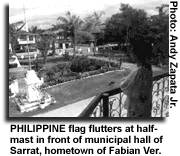| TravelSmart.NET
Archive Home |
|
| Inquirer.NET
Home |
|
| TravelSmart.NET
Home |
|

to life again
By Frank Cimatu
Ilocos Norte
 ON JUNE 11, 1983, Sarrat in Ilocos Norte was thrust
into the limelight when then presidential daughter Irene Marcos
married Gregorio ''Greggy'' Araneta at the town's old Sta. Monica
Cathedral.
ON JUNE 11, 1983, Sarrat in Ilocos Norte was thrust
into the limelight when then presidential daughter Irene Marcos
married Gregorio ''Greggy'' Araneta at the town's old Sta. Monica
Cathedral.
Described by her mother, Imelda Marcos, as the most romantic of her children, Irene chose to rebuild the ruins of Sta. Monica, considered as the biggest church in Ilocos. But the church was repeatedly ravaged by earthquakes.
The wedding rivaled that of Prince Charles and Lady Diana's. White scented flowers were all around. The bride was driven in a resplendent horse-drawn carriage.
Other couples with similar romantic inclinations were also thinking of getting married in the rebuilt ruins of Sta. Monica.
But not even the ''wedding of the century'' can destroy the idyllic reputation of Sarrat. More than two months later, on Aug. 17, an earthquake of Intensity 7.6 ravaged Ilocos Norte and destroyed the altar and belfry of Sta. Monica.
Some people saw this as an omen of the fall of the Marcos empire. Granta Magazine's James Fenton said another omen was the assassination of Ferdinand Marcos's political rival, former Sen. Benigno ''Ninoy'' Aquino Jr., that same year.
Marcos's most loyal ally and Armed Forces chief of staff, Gen. Fabian Ver, was tagged as the main man behind the Aquino killing. Marcos, however, somehow stood by his close friend and during the last days of his regime when generals and allies were defecting and changing loyalties, only Ver stood by Marcos's side.
The death of Ver last Saturday and the fate of his burial just brought his and Marcos's alliance back to the limelight and back to where it started.
 Sarrat is a sleepy town of 25,000 people. You have
to make a detour to the southeast to reach it from Laoag City.
No fast-food chain bothered to put up a stand in the town and
maybe not within the next five years.
Sarrat is a sleepy town of 25,000 people. You have
to make a detour to the southeast to reach it from Laoag City.
No fast-food chain bothered to put up a stand in the town and
maybe not within the next five years.
But Sarrat is the hometown of many interesting heroes and personalities.
Councilor Mervin de la Cuesta began writing a book, ''Sarrat: Cradle of Heroes,'' when he was 15. Fifteen year later, he is still looking for a publisher and enough heroes to fill up the pages.
Former newspaper editor and diplomat Modesto Farolan was born here. De la Cuesta acknowledged him as the ''Father of Philippine Tourism.''
Journalist and National Democratic Front spokesperson Antonio Zumel and his brother, Gen. Jose Zumel, grew up in Sarrat.
On Sept. 11, 1917, Ferdinand Marcos was born in a house in Barangay San Agustin in Sarrat. The Marcos house, now a brick-and-mortar edifice, is abandoned. No one stays there anymore. A Marcos museum is also gathering dust nearby.
Fabian Ver was born a few meters from the Marcos house on Jan. 20, 1920. It was nostalgic to imagine that the two played together, although Marcos's family later left Sarrat and the future president grew up in Batac town and in Manila.
Both Marcos and Ver had teachers for a mother. Josefa Edralin Marcos and Doña Elena Jamiar Ver were public school teachers and studied at the Philippine Normal School. Marcos' father, Mariano, died during World War II.
Ver's biodata in many Sarrat town fiesta souvenir programs did not bother to put the name of his father. Other sources said his father, Juan Crisologo, was a retired Army colonel from Batac.
Josefa and Elena were Sarrateños. Mariano and Juan were Bataqueños.
Like Marcos, Ver also took up law at the University of the Philippines. But even then, Ver's military inclination shone through. He became national commander of the UP Vanguard, the state university's ROTC fraternity.
He finished his law studies at the University of Manila. He then took up training on intelligence work at the United States Army in Hawaii and the intelligence division of the Los Angeles police detachment.
During the war, he joined the guerrilla forces of the 7th Company, 2nd Infantry Battalion of the 1st Regiment of the USAFIP-Northern Luzon.
Marcos later included Ver in the ''infamous'' Maharlika unit to bolster his reputation as a war hero worthy of his many war medals which many believed were fake.
In March 1950, while a commissioned first lieutenant in Montalban, Rizal, Ver thwarted an attack by Huk forces. On June 30, 1957, Ver was commissioned in the Armed Forces of the Philippines. In 1970, he became a senior aide-de-camp to President Marcos and on March 24, 1971, Ver earned his first star.
On Aug. 15, 1981, Marcos chose Ver as chief of staff over Fidel Ramos.
Ramos, of course, led the defection in the military that paved the way for the Edsa Revolution which toppled Marcos.
Radio commentators in Ilocos Norte are clamoring for a joint burial for Marcos and Ver.
Marcos' body is still in a semi-mummified stage in a refrigerated crypt in Batac. A plan to bury him at the Libingan ng mga Bayani met vehement opposition from anti-Marcos activists and even ultraleftists.
The call for Ver's body to be buried at Libingan has met lesser if not without opposition. But if Ver's 97-year-old mother, Doña Elena, would have her way, she prefers that her son be buried in Sarrat because of apparent retaliation from forces who believe that Ver was responsible for Aquino's murder.
If ever that happens, Marcos's close and tested friend
will be buried before him. Ver will be testing the waters, so
to speak, for the Apo while awaiting a favorable tide in history.
![]()